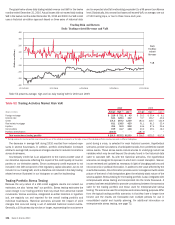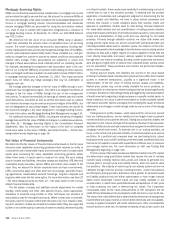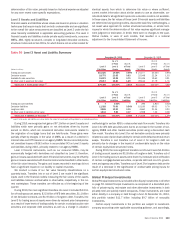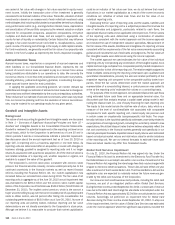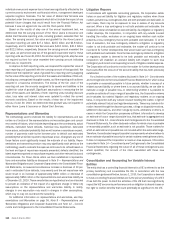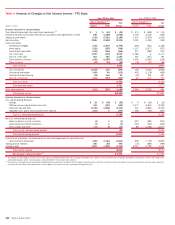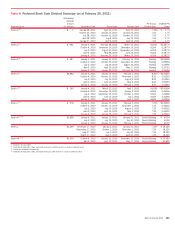Bank of America 2010 Annual Report Download - page 114
Download and view the complete annual report
Please find page 114 of the 2010 Bank of America annual report below. You can navigate through the pages in the report by either clicking on the pages listed below, or by using the keyword search tool below to find specific information within the annual report.Mortgage Servicing Rights
MSRs are nonfinancial assets that are created when a mortgage loan is sold
and we retain the right to service the loan. We account for consumer MSRs at
fair value with changes in fair value recorded in the Consolidated Statement of
Income in mortgage banking income. Commercial-related and residential
reverse mortgage MSRs are accounted for using the amortization method
(i.e., lower of cost or market) with impairment recognized as a reduction of
mortgage banking income. At December 31, 2010, our total MSR balance
was $15.2 billion.
We determine the fair value of our consumer MSRs using a valuation
model that calculates the present value of estimated future net servicing
income. The model incorporates key economic assumptions including esti-
mates of prepayment rates and resultant weighted-average lives of the MSRs,
and the option-adjusted spread (OAS) levels. These variables can, and gen-
erally do change from quarter to quarter as market conditions and projected
interest rates change. These assumptions are subjective in nature and
changes in these assumptions could materially affect our operating results.
For example, decreasing the prepayment rate assumption used in the valu-
ation of our consumer MSRs by 10 percent while keeping all other assump-
tions unchanged could have resulted in an estimated increase of $907 million
in mortgage banking income at December 31, 2010. This impact provided
above does not reflect any hedge strategies that may be undertaken to
mitigate such risk.
We manage potential changes in the fair value of MSRs through a com-
prehensive risk management program. The intent is to mitigate the effects of
changes in the fair value of MSRs through the use of risk management
instruments. To reduce the sensitivity of earnings to interest rate and market
value fluctuations, securities as well as certain derivatives such as options
and interest rate swaps may be used as economic hedges of the MSRs, but
are not designated as accounting hedges. These instruments are carried at
fair value with changes in fair value recognized in mortgage banking income.
For more information, see Mortgage Banking Risk Management on page 110.
For additional information on MSRs, including the sensitivity of weighted-
average lives and the fair value of MSRs to changes in modeled assumptions,
see Note 25 – Mortgage Servicing Rights to the Consolidated Financial
Statements. Also, for information on the impact of the time to complete
foreclosure sales on the value of MSRs, see Recent Events — Certain Ser-
vicing-related Issues beginning on page 38.
Fair Value of Financial Instruments
We determine the fair values of financial instruments based on the fair value
hierarchy under applicable accounting guidance which requires an entity to
maximize the use of observable inputs and minimize the use of unobservable
inputs when measuring fair value. Applicable accounting guidance estab-
lishes three levels of inputs used to measure fair value. We carry trading
account assets and liabilities, derivative assets and liabilities, AFS debt and
marketable equity securities, certain MSRs and certain other assets at fair
value. Also, we account for certain corporate loans and loan commitments,
LHFS, commercial paper and other short-term borrowings, securities financ-
ing agreements, asset-backed secured financings, long-term deposits and
long-term debt under the fair value option. For more information, see Note 22
– Fair Value Measurements and Note 23 – Fair Value Option to the Consol-
idated Financial Statements.
The fair values of assets and liabilities include adjustments for market
liquidity, credit quality and other deal specific factors, where appropriate.
Valuations of products using models or other techniques are sensitive to
assumptions used for the significant inputs. Where market data is available,
the inputs used for valuation reflect that information as of our valuation date.
Inputs to valuation models are considered unobservable if they are supported
by little or no market activity. In periods of extreme volatility, lessened liquidity
or in illiquid markets, there may be more variability in market pricing or a lack of
market data to use in the valuation process. In keeping with the prudent
application of estimates and management judgment in determining the fair
value of assets and liabilities, we have in place various processes and
controls that include: a model validation policy that requires review and
approval of quantitative models used for deal pricing, financial statement
fair value determination and risk quantification; a trading product valuation
policy that requires verification of all traded product valuations; and a periodic
review and substantiation of daily profit and loss reporting for all traded
products. Primarily through validation controls, we utilize both broker and
pricing service inputs which can and do include both market-observable and
internally-modeled values and/or valuation inputs. Our reliance on this infor-
mation is tempered by the knowledge of how the broker and/or pricing service
develops its data with a higher degree of reliance applied to those that are
more directly observable and lesser reliance applied to those developed
through their own internal modeling. Similarly, broker quotes that are execut-
able are given a higher level of reliance than indicative broker quotes, which
are not executable. These processes and controls are performed indepen-
dently of the business.
Trading account assets and liabilities are carried at fair value based
primarily on actively traded markets where prices are from either direct market
quotes or observed transactions. Liquidity is a significant factor in the
determination of the fair value of trading account assets and liabilities.
Market price quotes may not be readily available for some positions, or
positions within a market sector where trading activity has slowed significantly
or ceased. Situations of illiquidity generally are triggered by market perception
of credit uncertainty regarding a single company or a specific market sector. In
these instances, fair value is determined based on limited available market
information and other factors, principally from reviewing the issuer’s financial
statements and changes in credit ratings made by one or more of the ratings
agencies.
Trading account profits (losses), which represent the net amount earned
from our trading positions, can be volatile and are largely driven by general
market conditions and customer demand. Trading account profits (losses) are
dependent on the volume and type of transactions, the level of risk assumed,
and the volatility of price and rate movements at any given time within the ever-
changing market environment. To evaluate risk in our trading activities, we
focus on the actual and potential volatility of individual positions as well as
portfolios. At a portfolio and corporate level, we use trading limits, stress
testing and tools such as VaR modeling, which estimates a potential daily loss
that we do not expect to exceed with a specified confidence level, to measure
and manage market risk. For more information on VaR, see Trading Risk
Management beginning on page 104.
The fair values of derivative assets and liabilities traded in the OTC market
are determined using quantitative models that require the use of multiple
market inputs including interest rates, prices and indices to generate con-
tinuous yield or pricing curves and volatility factors, which are used to value
the positions. The majority of market inputs are actively quoted and can be
validated through external sources including brokers, market transactions
and third-party pricing services. Estimation risk is greater for derivative asset
and liability positions that are either option-based or have longer maturity
dates where observable market inputs are less readily available or are
unobservable, in which case quantitative-based extrapolations of rate, price
or index scenarios are used in determining fair values. The Corporation
incorporates within its fair value measurements of OTC derivatives the net
credit differential between the counterparty credit risk and our own credit risk.
The value of the credit differential is determined by reference to existing direct
market reference costs of credit, or where direct references are not available,
a proxy is applied consistent with direct references for other counterparties
that are similar in credit risk. An estimate of severity of loss is also used in the
112 Bank of America 2010






